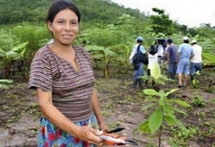The ‘miracle of San Martín’ and symptoms of ‘alternative development’ in Peru
Temas
Regiones
The Peruvian government has presented the “Miracle of San Martin Model” as the path to follow to achieve drug supply reduction. However a closer look reveals that the model is not replicable, not ecologically sustainable, and won't remedy the ‘symptoms of alternative development’.

Descargas
Autores
Since 2007 the Peruvian government, through the National Commission for Development and Life without Drugs (DEVIDA) and more recently the President of the Republic himself, have been presenting the “Miracle of San Martin Model”2 as the path to follow in order to achieve drug supply reduction in a targeted area within the country that was previously plagued by coca crops, guerrilla insurgency, lack of State presence and ecological damage.
The model contains four complimentary actions within one strategy: first, the eradication of coca crops in a voluntary and/or compulsory manner; secondly, eradication as a precondition to securing governability and security in the zones in which the strategy is applied; thirdly, coordination of the various activities of state and private entities and international cooperation; fourthly, the promotion of sustainable economic activities.
The strategy intends to demonstrate the success of these actions in order to reproduce them in other areas within the coun try and abroad as the only intelligent and successful way of reducing poverty, ensuring governability, and generating hope amongst the people and agricultural producers in the zones in which it is applied. Rómulo Pizarro, executive president of DEVIDA, and his co-workers have succeeded in launching a huge publicity campaign to promote the San Martin model. The model, however, reminds us more of the miracles of his namesake San place in Bangkok, is the discussion on the suitability and replication of the “San Martín model”.
Whilst recognizing its short-term successes, we maintain that this model is not new, and that it is not replicable, nor will it withstand the test of time. What is more, the model is not ecologically sustainable, and it doesn’t remedy the ‘symptoms of alternative development’.
Conclusions & Recommendations
We recommend a three-pillar strategy of Integral Harm Reduction:
- Concerning production and crops, we propose comprehensive sustainable human development -with people and with legal coca- that respects local cultures and knowledge, protects the ecology, manages natural resources, strengthens social and public institutions.
- Promote an efficient credit system- not a money lender, allocate permanent technical help, subsidize prices in order to protect them from the fluctuations of international prices and, above all, to encourage the purchase of these products and others for internal consumption.
- Change the exportation strategy to an internal market strategy, to not make forced or ‘voluntary’ crop eradication a precondition for development, and to talk with the farmers about alternative crops and economies in areas which are mainly suited to forestry, agro-forestry and ecotourism.
- The government and international cooperation should facilitate and promote national and international private investment in the coca zones through fostering systems of contract agriculture and creating “clusters”, or territorial conglomerations that guarantee the competetivity of different activities which should not be only agricultural, but alternative methods of generating family income to that of coca cultivation destined for cocaine production.
Pages: 12